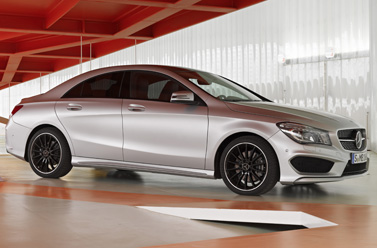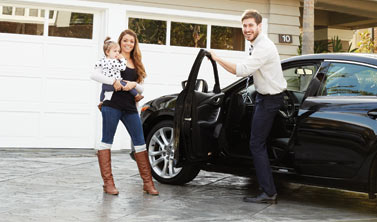Let's Make a Deal: Best New Car Values, 2014
We pick the best new cars for your money in 13 categories. Plus: We tell you how to get a sweet price while supply is lush.


Dealers’ lots are packed with 2014 car models ripe for a deal—there’s sure to be something for every buyer and every budget. High-end carmakers are luring buyers with lower-priced models, and mainstream brands are loading their vehicles with features that used to be found only on luxury models. American cars are back in a big way, with General Motors and Chrysler introducing impressive new models in an attempt to play catch-up with Ford and the foreign competition. And nearly every carmaker is offering a menu of green powertrains, from hybrid to electric to diesel.

Brian Byrne with his wife, Kodye, and daughter Makena. Amanda Friedman
The 2014 Mazda6 midsize sedan’s upscale feel and reasonable price sold Brian Byrne (the redesigned Mazda6 wins our Best New Car award in the $20,000-to-$25,000 category). He and his wife, Kodye, of Aliso Viejo, Cal., are Mazda loyalists; both previously owned Mazda3s, and Kodye now drives a CX-9 crossover. But after Brian was promoted to district sales manager for a stainless-steel distributor, he needed something classier to drive clients around in. “Inside and out, it looks more expensive than what I’m paying,” he says, noting that the navigation display reminds him of the one in BMW models. Brian pays $275 a month to lease the Mazda6, and he plans to purchase the car when the lease is up.

Sign up for Kiplinger’s Free E-Newsletters
Profit and prosper with the best of expert advice on investing, taxes, retirement, personal finance and more - straight to your e-mail.
Profit and prosper with the best of expert advice - straight to your e-mail.
Quality gaps between brands are narrowing—and that includes differences once common between foreign and domestic makes. “I don’t see a lot of difference in build quality between a Malibu and a Mercedes,” notes Visnic. J.D. Power’s Initial Quality Study rates GMC and Chevrolet in second and fifth place, respectively (Porsche tops the list, and Lexus and Infiniti round out the top five brands). All of GM’s brands score above the industry average.
Lou Palumbo has been a devoted buyer of Chevrolet Suburbans for his private security business, but he struggled to find an American sedan that he felt was worth the money. That changed when the New Yorker test-drove the redesigned Chevrolet Impala. “It’s comparable to most high-end foreign cars,” he says. “Fit, finish and amenities—it’s the whole package.”
Use Our Tool: Compare Cost, Fuel-Efficiency & More
Infotainment technology continues to filter down from pricey models to mainstream cars. New systems make greater use of your smart phone’s capabilities and enable you to do more without taking your hands off the wheel. In-car apps can connect you to Pandora Internet radio, read text messages aloud, and even give you audio Facebook and Twitter updates.
It’s not all good news, though. As more technology enters the car, concerns about distracted driving increase. And although mechanical quality has improved, J.D. Power’s Dave Sargent notes that consumer complaints about tech systems have gone up. “Consumers aren’t complaining about the engine or the brakes failing—it’s that the navigation freezes or the voice recognition isn’t working,” he says. Most of the problems stem from systems that are not intuitive enough for the average consumer. But it’s not entirely the manufacturers’ fault, he says. “Consumers are legendary for not reading owners’ manuals.”
You can now find advanced safety technology in all but the cheapest rides (see How to Buy a Safe Car). Rearview cameras are available on 70% of vehicles this year—and are often standard equipment. (Former NHTSA administrator David Strickland told Kiplinger’s that the agency would add rearview cameras to its list of recommended technologies but would not require the equipment anytime soon.) And active safety features—such as lane-departure warning, blind-spot monitoring and forward-collision warning, which uses sensors to help you keep a safe distance from the vehicle in front of you—are spreading quickly as well. These features are options on mainstream compact cars such as the redesigned Mazda3 and Mini Cooper Hardtop and on midsize sedans such as the Ford Fusion, Honda Accord and Subaru Legacy.
The bar continues to rise for crash testing. For the 2014 model year, the Insurance Institute for Highway Safety revamped the criteria it uses for its Top Safety Pick designation. The institute now requires vehicles to earn “good” or “acceptable” ratings on all of its tests in order to earn the coveted award. That includes the small overlap test, which simulates a crash in which only one-fourth of the car’s front end strikes a barrier. A model that not only has top crash-test results but also is equipped with forward-collision warning is named a Top Safety Pick+. The IIHS’s increasingly strict criteria mean that just 39 vehicles received either award—a stark contrast to the 130 vehicles that won them last year.
MPG Marches On
The government’s Corporate Average Fuel Economy (CAFE) standards require carmakers to increase fuel economy about 4% each year from 2012 to 2016, eventually bringing the average for all vehicles sold in the U.S. to 35.5 miles per gallon. To reach that goal, automakers have introduced more hybrids, plug-in hybrids and pure-electric vehicles, as well as diesel options. The internal-combustion engine continues to evolve, employing fuel-saving technology such as turbocharging and direct injection.
Manufacturers have quietly added more hybrids to their lineups, and they’re getting better with each iteration. Honda’s second attempt at a hybrid Accord is a success, says John Voelcker, editor of Green Car Reports. “It’s a big midsize sedan that’s powerful and quiet. You can get up to 48 mpg in real-world driving, edging into Prius territory.”
Plug-in hybrid sales have been disappointing because the vehicles are too expensive for most buyers, and sales of pure-electric vehicles are still a sliver of the market. Plug-in hybrid owners are still paying up at the gas pump unless they take a lot of short trips and charge the battery after each one. For the majority of consumers, the price premium over a traditional hybrid doesn’t make sense.
[page break]
Except for the Tesla Model S (see Putting Tesla to the Test), today’s electric vehicles mostly have sub-100-mile ranges and are relegated to second-car status outside of the city. To perk up sales, carmakers have trimmed prices and are offering cut-rate leases (as little as $199 a month) on plug-in hybrids such as the Chevrolet Volt and electrics such as the Nissan Leaf. If you’re on the fence about a vehicle that plugs in, consider a lease as a way to test the waters.
Clean-diesel vehicles, by contrast, have no range issues. And after a couple of years that saw few developments, the technology is making a comeback. Audi added a diesel variant of nearly every model to its lineup this year, and BMW reintroduced some diesel models to the U.S. Plus, you now have some domestic choices. GM added a diesel option to the Chevy Cruze and the new Colorado small truck; Chrysler brought a diesel powertrain back to the Jeep Grand Cherokee and added one for the Ram truck.
Conventional vehicles are now approaching the fuel-economy ratings achieved by first-generation hybrids, but without the additional cost and poor performance. Continuously variable transmissions—automatics that can employ an unlimited number of gear ratios rather than relying on set gears—improve efficiency. The midsize Honda Accord and Nissan Altima use CVTs to help the cars achieve 36 miles per gallon or better on the highway. Small crossovers equipped with CVTs, such as the Nissan Rogue and the Subaru Forester, get 32 mpg or higher on the highway. Partly because of its CVT, the Mitsubishi Mirage is the first non-hybrid vehicle to achieve 40 mpg in combined city and highway driving.
Voelcker recommends taking EPA figures with a grain of salt and checking out real-world ratings by actual drivers before you buy. Several carmakers had to restate fuel-economy ratings recently after consumer complaints. A 10% difference from EPA numbers is reasonable, Voelcker says, but a larger disparity isn’t. You can find driver reports on FuelEconomy.gov as well as third-party sites such as Fuelly.com.
Getting the Deal Done
Transaction prices are near record highs—a recent average of $32,890. But dealers are in the mood to haggle, and financing is cheap. You’ll find auto loans with rates of 2% to 3% at banks and credit unions for top-tier borrowers, and many manufacturers offer even lower rates.
The best deals are in crowded, popular auto segments. The midsize sedan category has the most variety, followed closely by compact crossovers. As gas prices continue to retreat and buyers move to larger vehicles, you’ll find more wiggle room than normal on compacts and alternative-fuel cars. (Kiplinger’s forecasts that fuel prices will drop 10 cents per gallon, on average, in 2014.)
Incentives have largely transitioned from cash to financing. Jessica Caldwell, senior director for pricing and industry analysis for Edmunds.com, says cash-back deals still exist, but a lot of incentives are now in the form of “dealer objectives” (meaning the dealer is rewarded for making sales goals), which are harder for consumers to take advantage of. Manufacturers are pushing finance deals because the money is cheap and they can apply low rates to both buying and leasing. Zero-percent rates are common. Automakers recently offered no-interest financing on Ford Fusion, Nissan Altima and Toyota Camry for 60 months.
Once you’ve narrowed your choices, make sure you get the best possible deal. That means keeping emotion out of the process. Go to the dealership and test-drive the cars you’re interested in, then leave. Go home and go online to Edmunds, Kelley Blue Book or TrueCar to figure out what others in your area are paying for the car you’re considering.
Call or e-mail several dealers in your area, and work with the Internet sales manager to get a quote. Let him or her know you’re shopping around and that the best bid is going to win your business. You can research dealers at DealerRater.com to make sure other customers report a positive experience.
Robert Ellis, vice-president of operations at CarBargains, a car-buying service, recommends getting all bids, including for options, relative to the invoice price because that’s a static number. Hate haggling? For $250, CarBargains uses its professional negotiators to solicit bids from at least five dealers in your area.
Keep negotiations for each transaction completely separate. Alec Gutierrez, senior analyst at Kelley Blue Book, says dealers have a four-part approach to negotiating—purchase price, trade-in, financing and down payment—and you should have a backup for each before you start the negotiations. The dealer may give you, say, a lower trade-in value if he sold you the new car at a rock-bottom price. Check out AutoTrader.com’s tool to get an offer online for your trade-in. Enter your vehicle’s details—features, mileage, damage and so on—and you’ll get an offer that’s good for 72 hours. Then take the car to an affiliated dealer or buying service to confirm the amount. You should also shop your old car around to several dealers and CarMax.
Next, line up financing. Check your credit score so you know what lenders will be seeing (see 6 Things to Know About Credit Scores). A dealer may offer you manufacturer financing at 0%, but if you go in with a car-loan preapproval, you can combine a cash-back offer from the manufacturer with low-rate financing from a third party (it’s usually an either-or proposition at the dealership). A dealer’s offer may not require a down payment, but to get the best rates at a bank or credit union, you’ll likely need to put 10% down.
Finally, consider a lease. Nearly 30% of new-car sales are leases. That number is growing because carmakers are pushing subsidized leases to keep buyers (and low-mileage used cars) coming back. If you trade in often enough to always have a car payment, or you’re looking to keep payments down on a more expensive car, leasing probably makes sense. Compare monthly payments at LeaseCompare.com.
Get Kiplinger Today newsletter — free
Profit and prosper with the best of Kiplinger's advice on investing, taxes, retirement, personal finance and much more. Delivered daily. Enter your email in the box and click Sign Me Up.

-
 Fired Up By the Masters and RBC Heritage? See These Homes for Sale By Golf Courses
Fired Up By the Masters and RBC Heritage? See These Homes for Sale By Golf CoursesFive homes for sale near golf courses, for people who can't get enough of the tour.
By Alexandra Svokos
-
 The Economic Impact of the US-China Trade War
The Economic Impact of the US-China Trade WarThe Letter The US-China trade war will impact US consumers and business. The decoupling process could be messy.
By David Payne
-
 Roth IRA Contribution Limits for 2025
Roth IRA Contribution Limits for 2025Roth IRAs Roth IRA contribution limits have gone up. Here's what you need to know.
By Jackie Stewart
-
 Four Tips for Renting Out Your Home on Airbnb
Four Tips for Renting Out Your Home on Airbnbreal estate Here's what you should know before listing your home on Airbnb.
By Miriam Cross
-
 Five Ways to a Cheap Last-Minute Vacation
Five Ways to a Cheap Last-Minute VacationTravel It is possible to pull off a cheap last-minute vacation. Here are some tips to make it happen.
By Vaishali Varu
-
 How to Figure Out How Much Life Insurance You Need
How to Figure Out How Much Life Insurance You Needinsurance Instead of relying on rules of thumb, you’re better off taking a systematic approach to figuring your life insurance needs.
By Kimberly Lankford
-
 Amazon Big Deal Days Is Coming! We’ve Got All the Details
Amazon Big Deal Days Is Coming! We’ve Got All the DetailsAmazon Prime To kick off the holiday season with a bang, Amazon Big Deal Days runs Tuesday, October 8 and Wednesday, October 9.
By Bob Niedt
-
 How to Shop for Life Insurance in 3 Easy Steps
How to Shop for Life Insurance in 3 Easy Stepsinsurance Shopping for life insurance? You may be able to estimate how much you need online, but that's just the start of your search.
By Kaitlin Pitsker
-
 Five Ways to Shop for a Low Mortgage Rate
Five Ways to Shop for a Low Mortgage RateBecoming a Homeowner Mortgage rates are high this year, but you can still find an affordable loan with these tips.
By Daniel Bortz
-
 Retirees, It's Not Too Late to Buy Life Insurance
Retirees, It's Not Too Late to Buy Life Insurancelife insurance Improvements in underwriting have made it easier to qualify for life insurance, which can be a useful estate-planning tool.
By David Rodeck